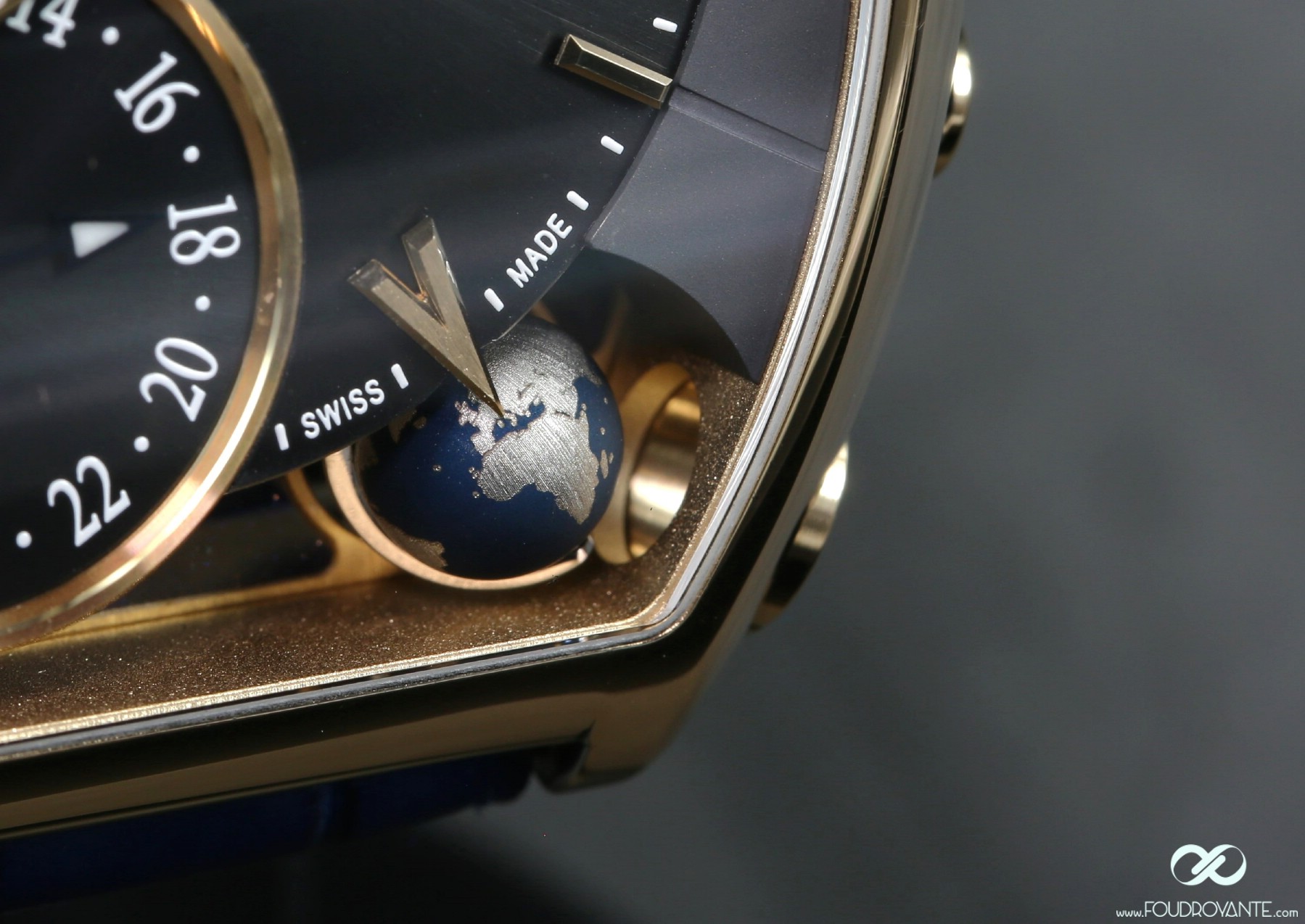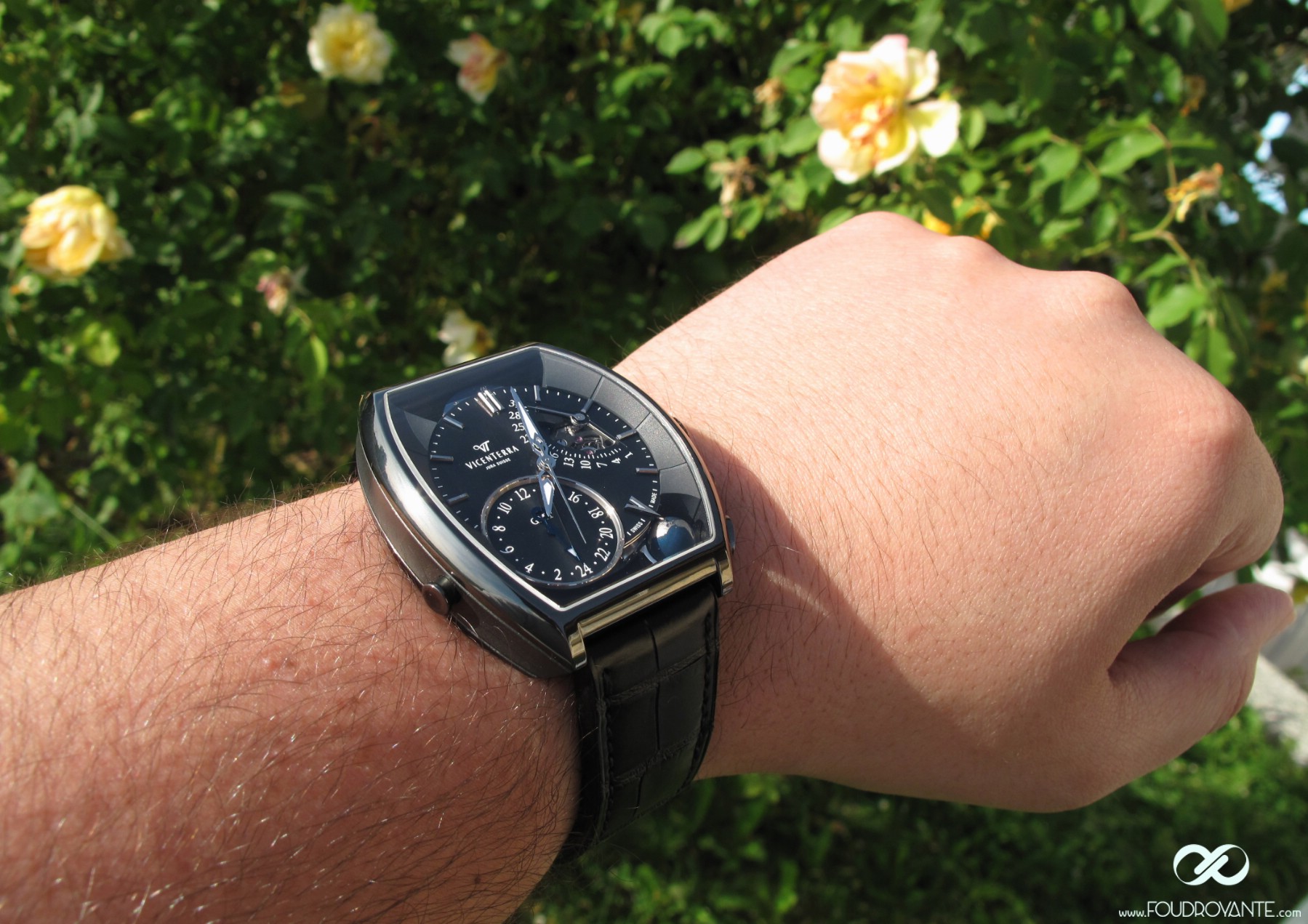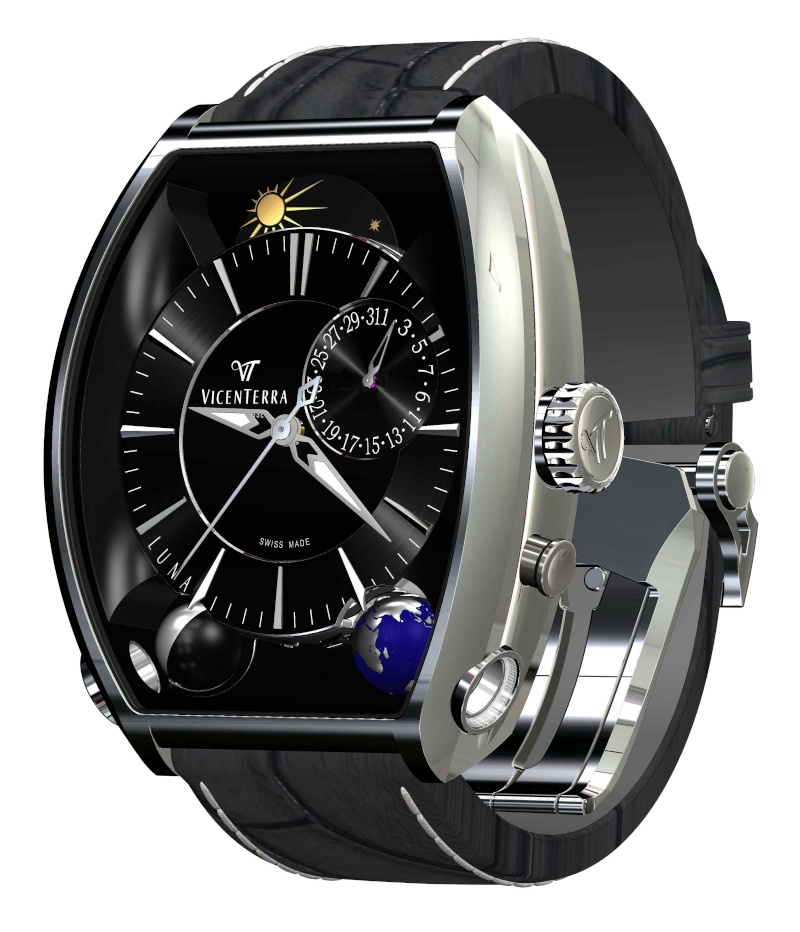VICENTERRA : Space Pirate

- Back to the future,
Spring 2010, I just got in Switzerland. In Business Montres, Gregory Pons publishes some computer-generated images of a stunning barrel watch:
for CHF5000 by subscription (paid beforehand to be later delivered).
it features a mini-earth globe, a multi-level dial, a day/night indicator, a GMT, ect…


This paltry sum, given the complexity of the project, make forumers doubt wether such a sophisticated piece can be realesed for so little money. We’ve been so accustomed to pay too much for watches… Me, I have to finance my moving in, and I don’t have the 5000 bucks required before the end of the subscription, yet the 3D earth continues to fascinate me.

Finally, 84 persons took the risk to follow Vincent Plomb. He convinced a large part of the skeptics by meeting and presenting them the project and the prototype (wich Vincent didn’t let me photograph, too bad, it’s my favourite VicenTerra). The customers of the first GMT-3 subscription were mainly French and Swiss who believed in the project and the person.
a Playboy issue can never replace a real call girl…
It also shows you the limits of the internet: we can discuss, quibble, gossip, argue about a watch, but nothing’s better than the meeting IRL. Although we take much more beauiful photos with increasingly efficient cameras,
- Even if you think you have balls, meeting Vincent is kind of a swipe in the face, a lesson of courage: he had a moto accident twenty or so years ago. This drama confined him to a wheelchair, wich causes many other health problems…
He doesn’t like when I talk about it, but we can only understand VicenTerra through the Way of the Cross of its creator. He’s been rising for many years to run several professional projects, in spite of all the huge difficulties arising from his handicap. Vincent Plomb is someone who finds the energy to fight where some well and able persons would not. To me, it’s a fucking lesson of courage but also of watchmaking.
He’s been working for many years as a watchmaking designer-maker. He also works from home as a consltant for prestigious watchmaking houses.
On the one hand, the original idea behind the creation of the GMT-3 came from the fascination for 3D moons (like De Bethune’s), but mainly from the fact that there are often empty spaces in a barrel case, because a generic watchmaking calibre type 7750 or 2824 (such as those initially used by Frank Muller, who brought the barrel back) is a small round calibre floating in a large barrel case.
In sum, Vicent pirated the vacant space of a barrel case,
- to stick a functional and fun complication in it: a 3D globe together with a GMT indicator.

He worked for 3 years to achieve two functional prototypes. But as many great inventions, nobody wanted them (at the time Vincent presented his project, the Hysek Colosso at ½ million was the only one to feature a 3D world map). If one of his clients had opted for this concept, tens of thousands of GMT-3 (whatever the name and the final brand would have been), would have flooded the market, with a panel of journalists enthused by this stroke of creative genius.
If the big machine of watchmaking marketing ignored it, the stroke of genius was definitly there, since the GMT-3 has gathered from 2007 (when the initial idea was born) a large part of the new independant watchmaking concepts, which broke daddy’s watchmaking taboos: multi-element dials, vacant spaces between the sapphire and the case back, barrel case, opened dial, three-dimensional effects, and above all, the functional 3D earth.

- Certainly scaled by the impossibility of selling his project, Vincent adopted a creative radicalism: independence, creation of his own brand and self-financing. A pirate project (latin root “Peiran”meaning “attempt, experience”)
given that he didn’t abide by the fine watchmaking codes, from the innovation to the method of financing: subscription, a very horizontal and community financing, just as life was aboard the brigs with black flags. A daring, light, mobile and risky project!
In pre-industrial economies, the subscription was a method of purchase for entry level watches, sold to rich urban bourgeois: the client paid a monthly rent before receiving his watch (the opposite of a leasing) to finance the production. At that time, Breguet or Harrisson had no acess to business angels to finance their creativity. Whithout money nor without computers, though, Breguet succeeded in designing the tourbillon…


When Vincent launched his first subscription, the money had been blocked on an account by a bailiff, until there was enough subscribers to start the production. This type of sale allowed him to finance his basic tool equipment without borrowing. As a finilasation of this community adventure, each customer of the first subscription received a share of the company. It wasn’t any better on the pirate ships: the spoil was equally shared, and only the captain, the cook, the doctor and the quartermaster were entitle to get an extra half-share. We’re far from the stratobonuses of Goldman Sachs.
Speaking of which, for those who don’t have the bonuses of a Wall Street trader, VicenTerra is the only brand that offers a functional 3D earth globe into a mechanical watch, affordable for the average watchmaking enthusiast. The others, Monblanc, Hysek, Greubel Forsey offer superlative products (especially the fantastic Greubel Forsey GMT Platine), for the price of a downtown condo. The Astronomia, by Jacob & Co, also features a 3D earth (still for half a million), but this one isn’t linked with hours, it’s just aesthetic, a pure gadget.
- The GMT have one point in common with those superwatches: it’s quite imposing (hard to stick a sphere into an extra-thin watch).


- This barrel shape conjures up a brig or a frigate. Let us use naval vessels vocabulary to describe the complicated construction of the GMT-3 (GMT-1&2 are prototypes never commercialized):
The hull: the case. It measures 44.6mm * 54.5mm * 13.65mm, made of steel, horns included on the Tome 1 & 2. In response to the criticism about the size of the case, Vincent reduced it on the new versions (GMT-3 Tome 3 & LUNA), to reach 43.5mm * 53mm * 13.65mm, horns included, of course. The watch is 50m waterproof, which provides resistance to unexpected dives in the swimming pool (or in the sea, if the boarding goes wrong). The Tome 3 was produced in 3 gold series of 7 copies each, Pink, Yellow & white gold. There’s also a set version of 7 pieces, and a Tome 5, a Titanium DLC version. I’ll come back to this one in a moment…
- My favourite version is the titanium DLC case of the Tome 5 (the photos are those of a prototype, a bit different from the final version). It somewhat sharpens up the watch on the wrist, and above all, it gives the impression that the earth globe is floating in themiddle of the space. Appropriate & hypnotic.

On the wrist, this barrel case is curved, and so hugs the arm. As often the barrel cases, the comfort is optimal (in spite of the large size). The flanks are slightly depressing, which helps to reduce the impression of thickness.
The prototype of the Tome5, final realease will not include waves in the dial bottom.


The mast: the cradles. That’s one of the special things about the VicenTerra GMT-3. Vincent wanted to achieve a three-dimensional effect, but couldn’t afford to develop an in-house calibre. The diameter of his globe being greater than the thickness of the ETA Valjoux 2892, the calibre had to be raised with respect to case back. The trick is to fasten the movement directly to the flanks of the case by its cradles, in order to keep the calibre off the ground (it’s not connected to the case back).
The cradles are sanded. On the first versions, they are striated in continuation of the hour indexes. Personally, I prefer the Luna, where they’re just sanded.
The sails: the calibre. Depending on the version, the GMT-3 has an ETA Valjoux 2892, frequency 28800 bph for 42h of PwR. The 2892 is encrusted with 21 rubies, the module too, so it’s 42 rubies in total. The future Luna will be equipped with a Vaucher calibre (the entity calibre by Parmigiani Fleurier).
The deck: the dial. Its general arrangement also tickles our watch culture: it reminds that of Greubel Forsey with the multi-element dials. Each element looks alive, and the watch is a mosaic of finishings and style. There’s the retrograde date hand that opens on the movement, or the V pointing to the earth, to name just a few. You either hate it or love it, but you get what you pay for, and it’s hard to get bored. I have a slight preference for the Roman numerals version (Tome 2) which provides a little more poise to the GMT-3, and is finally more in line with the general appearance of the watch.
The hold: the case back. I’m not talking about the back of the watch, but rather about the case back, viewed from the front. Depending on the version, it has personalised decorations. We find stars on the GMT-3, aventurine on the gold cases (blue stone, reminiscent of the decorative features), and waves on some prototypes…
The porthole: the windows. There are 3 of those openings: two at the back, one on the side. The two small open onto the earth, with the fun inscription “De l’autre côté du monde” (“On the other side of the world”),and the large one onto he calibre with the decorated oscillation weight.
The stern: day/night hand. This disc at 12H contributes significantly to the poetic aspect of the piece (it is also visible through the large “window”), but this complications is still at an early stage of development…
The bow: hand GMT. This single-hand meter is positioned near the mini-globe, making the reading of this last one easier. It’s adjustable by means of the button at 8H (1 press = 1 hour).
The figurehead: the 3D globe. It turns in 24 hours, and can be adjusted via the button at 4H (1press = 1 hour). The three indications, main time, time GMT and mini planet Earth can therefore be set independently of one another, which allows a great reading flexibility for frequent travellers.
- This model is as practical as it is aesthetically pleasing (it lacks a 24h scale to discern its time zones very precisely). This complication is a functional elaboration of an old idea found, for instance, in the vintage Patek world time.
When wearing it, it’s fascinating to look at, but only a wise eye could see that it’s not a watch to show off with, it’s rather a piece intended for those who already have a good level of knowledge of watchmaking.


VicenTerra will do its next boarding by night, with its new model: la Luna.
If the 43.5mm * 53mm * 13.6mm steel case remains unchanged, the complication evolves: the GMT indicator is replaced by a moon phase, 3D, of course.
To put things bluntly, what it laks in practical aspect, it gains in horological interest: first of all, it pirates even more the vacant spaces that we find in a barrel watch.
- But must of all, a combination of both 3D earth and moon into the same piece is a first in watchmaking.
And as any other Vincent’s offer, it’s affordable for the standard enthusiast. When I speak about watchmaking content, it’s at all levels: the case back systematically enjoys a stunning aventurine decor, representing a starry sky. More imprtantly, the calibre evolves: the 2892 is substituted by the Vaucher Seed VMF 3002. It has the same features as the 2892: 11 ½ lines (26mm) by 3.7mm, 27 rubies, 28800 bpf for 50h of PwR, twin barrel. The only significant difference is the finishings: even the most basic ones get close to fine watchmaking. Vaucher’s strenght lies offering customised calibres with high quality finishes, such as those by Parmigiani or Richard Mille.
From the synthetic images I’ve ssen, the most attractive Luna is the version with opened dial.
I speak of synthetic images and boarding because the Luna is a prototype. Vincent has just launched a second subscription, he offers a Luna for less than 10k…


Let us be clear about this piratesque metaphore, which I’ve used and abused throughout the article.
- Vincent will not show up from a rope, sabre between his teeth, screaming “yo ho, yo ho” and other “buccaneering, here I come”. This may be regrettable.
To undestand this metaphore, it’s necessary to know that sailors’ living conditions on board Spanish, French and especially English galleons were horrific. The crews were barely better treated than the slaves they were in charge to escort. There were many mutinies, the mutineers formed cooperatives and became pirates. Fundamentally, this practice and social organisation was a response to the machine to crush humans that was the race for colonial wealth.
Furthermore, the founding act of VicenTerra,and the resulting sequences of actions, stame from the same sense of freedom, justice, independence as the big machines: offer a very original watch, allowing to access rare and innovative complications, at an affordable price for any watchmakig enthusiast.


